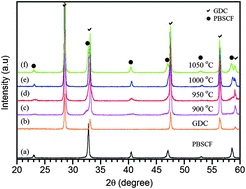A collaborative study of sintering and composite effects for a PrBa0.5Sr0.5Co1.5Fe0.5O5+δ IT-SOFC cathode
Abstract
Recently, a novel cathode material PrBa0.5Sr0.5Co1.5Fe0.5O5+δ (PBSCF) has been proposed as a solution to overcome the drawbacks of a conventional cathode for intermediate-temperature solid oxide fuel cells (IT-SOFCs). Here we report systematic procedures to optimize the sintering temperature and the composite for PBSCF as an IT-SOFC cathode. For optimization of the heat treatment conditions for a PBSCF composite cathode, the effects of sintering temperature on the microstructure and electrical transport properties of the material are examined. We also suggest the optimization processes to effectively expand the electrochemical reaction zone based on a combination of a mixed ionic and electronic conductor (MIEC) electrode and an ionically conducting phase (PBSCF-Ce0.9Gd0.1O1.95 (GDC)x, x = 0, 20, 40, 50, and 60 wt%). The optimal intersection point between these two processing systems is revealed to be 50 wt% of GDC containing a composite cathode sintered at 950 °C for 4 h. The area specific resistance (ASR) of PBSCF-GDC50 sintered at 950 °C for 4 h reaches a minimum value of 0.052 Ω cm2 at 600 °C, which is consistent with the electrochemical performance results representing peak power density of ∼2.0 W cm−2 at 600 °C.


 Please wait while we load your content...
Please wait while we load your content...